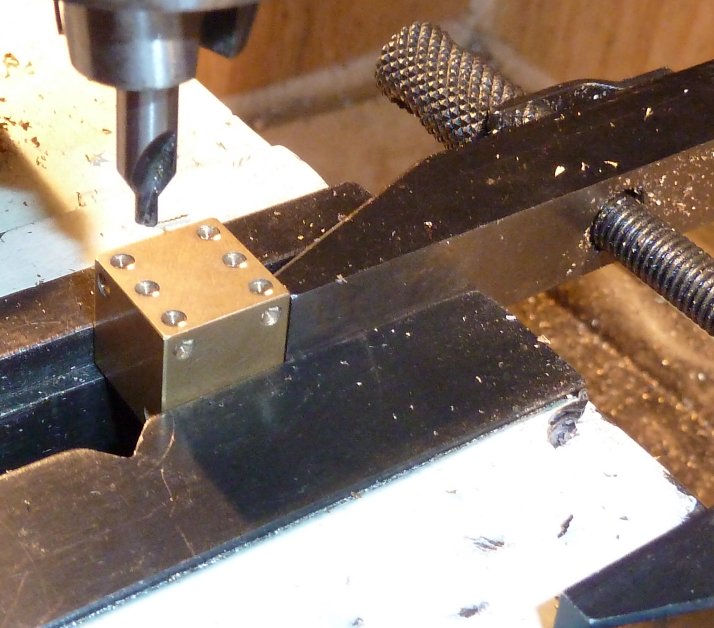Here are some notes on making dice (or just one die) in brass (etc) in the metalwork shop, suitable for a total beginner. I did it with my 10-year old. I used some half-inch square brass stock.
- Set the stock in the lathe using a 4 jaw chuck. Get it close to centred by sighting the edges against the cutting tool. I tend to face off with a TCMT (carbide tipped) tool where the tip points away from the tool post (i.e. a 60 degree angle to the work). I used my top speed of 1800RPM but you could go faster.
- Face it off.
- Mark out and cut off slightly over 1/2″ from the stock, file it down a bit to remove the unevenness.
- Fly-cut (1″ or slightly larger fly cutter) the sawn face to get to a cube. Use a speed of about 1100 RPM and work in stages of measure-then-cut. This is quite easy even in a small mill/drill. Lock the table in position and the head in place while cutting. A digital scale on the vertical axis is really useful for this (the vertical fine-feed on my machine is hopeless) . An alternative is just to face-off this end in the lathe but I find it easier to finish off at the correct length flycutting and it demonstrated the technique.
- Gently remove rough or sharp edges with a fine file or emery paper.
- Set up an arrangement like the photo. The tool clamp provides a positive location so that the die can be turned over and around and returned to the same position.
- Turn the cube over so that the previously-turned face is upper-most. Fit a centre-drill into the chuck with a point of the size you want the die dots to be. Traverse the milling table so that the centre of the face is lined up. The marks from the facing-off operation should be sufficient and give a nice appearance. (this is why you need to get it “close to centred” in step 1). Make sure you remember to take account of backlash in the leadscrews. I made sure I approached the centre by turning the handwheels in a clockwise direction. Zero the collars or mark off the handwheel positions carefully.
- Drill to depth. Set the depth-stop and drill again to meet the stop.
- Remove the die, rotate to another face, snug-it up against the tool clamp and secure the die. Drill another centre hole (say for the “3” side) then a final hole (say for the “5” side). Remember opposite sides of dice add up to seven.
- Decide where the corner dots will be and traverse both axes of the milling table to position the cube appropriately. Traverse the same distance for each axis. I opted for a whole number of revolutions of the handwheels for simplicity. Remember to turn them the same way as in step 7 to mitigate for backlash.
- Reclamp the table and drill a dot. Loosen the milling vice and rotate the die by quarter of a turn. Repeat until you’ve made the “5”. Use the same process to make the “3”.
- It should now be obvious how to make the “2” and “4”. The “6” is made by making a “4” then return one of the milling tables to its “zero” position (step 7). Reverse back past “zero” by about half a turn of the handwheel them advance back to “zero”. Clamp the table and drill. Rotate half a turn and complete the last hole.
- Polish it up, slightly round off the edges and corners and you are done.
My daughter was well pleased with the result and rather impressed by the simple little tricks that make it quite easy to get a neat and regular result with minimal fuss and fiddle: the trick with the tool clamp, rotating the die, the depth stop. If I were to make another, I think I would place the “spots” slightly further from the edges.
